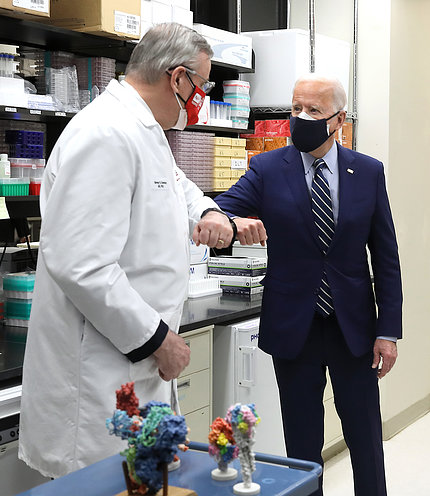||| FROM HEDRICK SMITH, RECLAIM THE AMERICAN DREAM |||
Washington – In his massive new infrastructure project, President Joe Biden is betting big that government financing can generate an array of technological innovations that will not only create millions of 21st-century jobs but vault the U.S. ahead of China and Europe in what economists now call the Fourth Industrial Revolution.
 “We’re going to invest in American workers and American science,” Biden told his first news conference. “We’re going to invest in medical research, cancer, Alzheimer’s, diabetes, industries of the future, artificial intelligence, quantum computing, biotech, and we’re going to make real investments. China is out-investing us by a long shot because their plan is to own the future.”
“We’re going to invest in American workers and American science,” Biden told his first news conference. “We’re going to invest in medical research, cancer, Alzheimer’s, diabetes, industries of the future, artificial intelligence, quantum computing, biotech, and we’re going to make real investments. China is out-investing us by a long shot because their plan is to own the future.”
But what’s striking is that Biden dares to defy the mantra of American laissez-faire capitalism, which preaches that the government get out of the way and let private enterprise dream up the space-age inventions and digital apps that will dazzle us and define our future.
Biden Has History on His Side
Biden is in for a tough political battle, but he has American history on his side – and some high profile Republican leaders.
From the Erie Canal to the telegraph of Samuel F. B. Morse to the Apollo moon shot to Project Warp Speed, the crash campaign to swiftly develop anti-corona vaccines, it is government risk-taking and taxpayer funding that took the bold leap into the unknown and spawned the core technologies of the Internet, nuclear energy, nanotechnology, computers, television, jet aviation, the GPS system, and the awesome wizardry of the smartphone from the touch screen to voice response.
Business and political critics are quick to point to government-funded failures in the past. Biden himself has come under fire for signing off as Vice President in the Obama Administration on a $528.7 million government loan to Fisker Automotive to make hybrid and electric vehicles and a controversial $535 million government loan guarantee to Solyndra, a California solar panel company, only to have both companies go belly up before they could deliver.
But despite those failures, the Obama administration’s clean energy spending created nearly a million jobs from 2013 to 2017, according to the National Bureau of Economic Research. And even with painful failures, government loan programs netted gains of $2 billion more in paybacks than the government lent out. “So the overall benefits of the Obama-era clean energy investments were overwhelmingly a net positive,” asserts Jennifer Granholm, Biden’s Energy Secretary.
The Hidden Science Behind Corona Vaccines

Fast forward to the corona pandemic. The reason that Pfizer and Moderna were able to develop vaccines at record speed was that the crucial discovery had been made by a government scientist at the National Institutes of Health, long before Covid-19 hit America in early 2020. That discovery came in one of those expensive, long-term research projects that only governments have the patience to fund because those projects don’t deliver the fast, short-term profits demanded by private capital.
Working for years on a MERS virus from the Middle East, Dr. Barney Graham at NIH devised the molecular engineering to combat a coronavirus. So when Chinese scientists published the genetic code of Covid-19 in January 2020, Dr. Graham’s team was ready with a laboratory recipe for the vaccine. “We just flipped it to coronavirus and said, ‘How fast can we go?’” Dr. Graham told The New York Times.
The Trump Administration, unable or unwilling to cope head-on with the pandemic, pounced on Dr. Graham’s discovery and used it to negotiate partnerships with major drugmakers. Through the Defense Production Act, the government procured the necessary materials and committed billions of tax dollars to finance research, clinical trials, and retrofitting pharmaceutical plants. It pledged billions more to buy millions of doses of vaccine, protecting private firms from financial risk and handing them the prospects of enormous future profits from government-funded R&D.
Government Spawned Big US Tech Innovation
The Corona story follows a well-honed pattern of the U.S. government as innovator-in-chief, especially during wartime and times of crisis, acting as the catalyst for quantum changes in technology through the tax-funded operations of agencies like the National Institutes of Health and DARPA, the Defense Advanced Research Projects Agency.
 In her pioneering book, The Entrepreneurial State, economist Marianna Mazzucato tells how in case after case, it has been the American government, not private enterprise, that has taken the big risks to achieve major scientific and technological breakthroughs that then kick-start a multitude of me-too, private sector add-ons, building on government-driven breakthroughs.
In her pioneering book, The Entrepreneurial State, economist Marianna Mazzucato tells how in case after case, it has been the American government, not private enterprise, that has taken the big risks to achieve major scientific and technological breakthroughs that then kick-start a multitude of me-too, private sector add-ons, building on government-driven breakthroughs.
In Mazzucato’s account of economic history, the Internet was the offspring of ARPAnet, which was the brainchild of DARPA and the Pentagon in the early 1960s. Then, in the 1970s, GPS emerged from a military navigational program called NAVSTAR.
As for the ubiquitous smartphone, Mazzucatto reports that it was not Silicon Valley but government-funded research by a professor at the University of Delaware that gave birth to the touchscreen technology, made possible not by private investors but by grants from the National Science Foundation and the CIA. Even Siri, the cheerful voice of the iPhone, was not the creation of Apple and founder Steve Jobs. Rather, it was a spinoff from an artificial intelligence project mounted by DARPA. And the list goes on.
Even Gingrich and Reagan Back Federal R&D
It is that dynamic, forward-looking strategy that President Biden is now tapping into, with the warning that the Chinese and Europeans are investing public funds in modern technologies while publicly funded research in the U.S. has fallen from roughly two percent of GDP in the 1960s to only seven-tenths of one percent today.

Surprisingly to some, Biden is echoing themes from Republican leaders like former President Dwight Eisenhower who got Congress in the 1950s to fund the interstate highway system. More recently, former House Speaker Newt Gingrich who warned a few years ago in a New York Times op-ed that “it’s irresponsible and shortsighted, not prudent, to let financing for basic research dwindle.” Even Ronald Reagan called on Congress to invest hundreds of millions of dollars in Sematech, a public-private partnership designed to restore American technological leadership and innovation that was threatened by Japanese computer firms.
In the same vein, Joe Biden observes: “The future lies in who can in fact own the future as it relates to technology, quantum computing, a whole range of things…We rank 13th globally in infrastructure. China is investing three times more in infrastructure than the united states is …and so what I’m going to do is make sure we invest closer to 2%. … to rebuild the infrastructure, both physical and technological infrastructure of this country so that we can compete.”
The test is whether in this severely divided country, torn by racial and cultural antagonisms and mired in misinformation, will hear and heed Biden’s warning and then whether the President from his bully pulpit can move a divided Congress to take action to re-ignite America’s historic genius for out-thinking and out-working the world.
**If you are reading theOrcasonian for free, thank your fellow islanders. If you would like to support theOrcasonian CLICK HERE to set your modestly-priced, voluntary subscription. Otherwise, no worries; we’re happy to share with you.**










As a physician, I see daily how government backed research and transfer of technology to the private sector is life-saving. The MRI is a classic example. Proud to see our government take the risk of investing in science and technology to better the lives of all Americans.
With all due respect;
Biden, a vague centerest Dempublican, is better than the previous office-holder.
However, he is certainly not innovative.
re: The Hidden Science Behind Corona Vaccines:
Even though I have had my first vaccine, there is plenty of room for skepticism of the mRNA gene-therapy medicines.
We are all part of the vaccine trials as we speak.
Let’s hope it works and we don’t have another Thalidomide problem:
https://en.wikipedia.org/wiki/Thalidomide
re: Government Spawned Big US Tech Innovation:
The internet was a result of the “pacification” project in Vietnam.
Read “Surveillance Valley” by Yasha Levine.
https://www.covertbookreport.com/review-surveillance-valley-by-yasha-levine/
There is nothing to celebrate about DARPA and the CIA, agencies that have caused so much human damage, involving their long arms into public health issues.
And finally, I seek no refuge in Newt Gingrich comments.
What I sense from the analysis is more China-bashing and a return to the new cold war.